Revell 1/32
Spitfire V
|
KIT #: |
? |
|
PRICE: |
? |
|
DECALS: |
Two options |
|
REVIEWER: |
Tom Cleaver |
|
NOTES: |
Lifelike 32-013 and Eagle Strike decals used. |
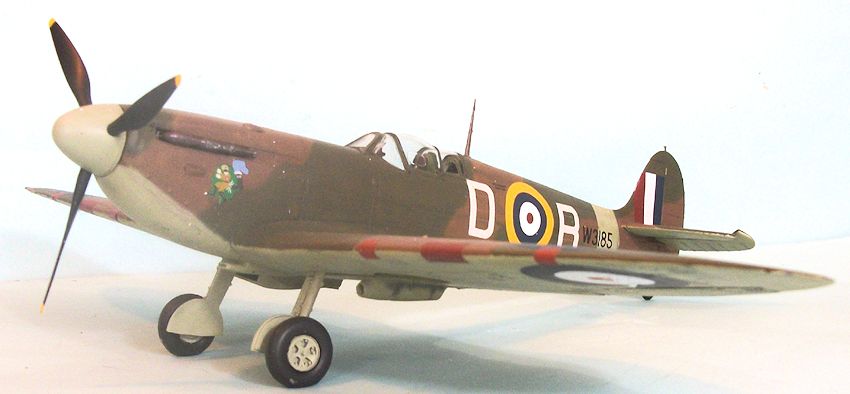
In the
development of the Spitfire, there is a recurring theme: that outside of the
Mk.I, each major sub-type used was actually a “stopgap” design while the
“definitive” design undertook more prolonged development.
This applies to the Spitfire V, the Spitfire IX and the Spitfire XIV.
Following the end of the Battle of Britain, Fighter Command predicted
that the high-altitude Junkers Ju-86P would become the primary bomber type to be
intercepted, and requested that Supermarine develop a high-altitude version of
the Spitire. This would appear as
the Mk. VI. In the meantime, the
first Bf-109Fs had appeared on the Channel Front and it was evident this 109
outperformed both the Spitfire I and II.
Supermarine then proposed a “stopgap” fighter utilizing the same
Merlin-45 engine as the Spitfire VI, mated to a “beefed up” Mk. I airframe.
(This would be the same scheme that would result in both the Spitfire IX
and the Spitfire XIV).
The first Spitfire V appeared in December 1940, and initial production of
the sub-type involved utilization of modified Mk. I airframes at the Supermarine
factory in Southhampton and Mk.II airframes at Castle Bromwich.
The first squadrons to equip with the new type received their Spitfire Vs
in April 1941. Over the course of
the spring and summer of 1941, all of Fighter Command’s Spitfire squadrons and
many of the Hurricane squadrons would re-equip on the Spitfire V, with the last
Mk. Is disappearing from operations in June and the last Mk.IIs by late
September 1941.
In addition to the Merlin 45, which provided 1,450 horsepower as opposed
to the 980 h.p of the Merlin “C” in the Mk. I and the 1,175 h.p. of the
Merlin-XII in the Spitfire II, the Spitfire V also introduced a single-stage
two-speed supercharger that increased operational ceiling to 35,000 feet with
“best altitude” at 29,000 feet (as opposed to the 20,000 feet of the two earlier
types). Additionally, the Spitfire
V had metal-framed ailerons which vastly improved high-speed roll.
Over the course of the spring and summer of 1941, Spitfire IIs were also
re-equipped with the new ailerons, following Douglas Bader’s side-stepping of
regulations in late April to obtain them for the Tangmere Wing he led.
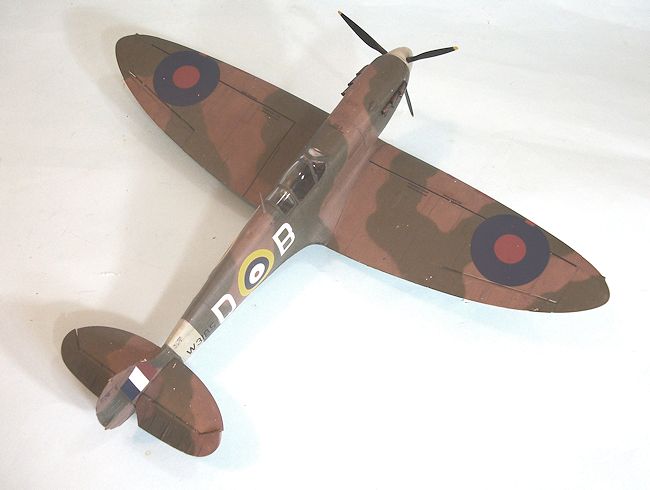 The Spitfire V first appeared as the Type 331, known as the Spitfire Va.
94 were built with the “A” wing carrying eight .303 Colt-Browning machine
guns. This sub-type had a top speed
of 375 mph, and could climb to 20,000 feet in 7.1 seconds.
The best known of these Spitfires is W3185, which was flown by Douglas
Bader as commander of the Tangmere Wing and in which he was lost on August 9,
1941.
The Spitfire V first appeared as the Type 331, known as the Spitfire Va.
94 were built with the “A” wing carrying eight .303 Colt-Browning machine
guns. This sub-type had a top speed
of 375 mph, and could climb to 20,000 feet in 7.1 seconds.
The best known of these Spitfires is W3185, which was flown by Douglas
Bader as commander of the Tangmere Wing and in which he was lost on August 9,
1941.
Douglas Bader and
“the Non-Stop Offensive”:
Following the Battle of Britain, both Air Marshal Hugh Dowding, OC
Fighter Command, and Air Vice Marshal Keith Parks, OC 11 Group - the two men who
had won the Battle of Britain - were replaced.
Air Marshal Sholto-Douglas (a long-time opponent of Dowding) took over
Fighter Command, while Air Vice Marshal Leigh-Mallory (Parks’ main opponent
other than the Luftwaffe during the Battle of Britain) took over at 11 Group.
Both men had opposed the strategy and tactics used by Dowding and Parks
during the battle, believing that massing defending fighters in larger
formations was the key to success.
That such a strategy would have lost the battle, as revealed when its leading
proponent, Squadron Leader Douglas Bader, was allowed to develop a “Big Wing” in
12 Group based at Duxford that proved unable to assemble in time to attack the
Germans before they had done their damage and were on the way home, did not
diminish his stature with his new commanders, with whom he had close
relationships.
Both Sholto-Douglas and Leigh-Mallory favored a “lean into France”
strategy of going on the offensive against the Germans in France.
There was the problem that the short range of the Spitfire and Hurricane
made it impossible to penetrate northern France much further inland than Rheims,
while the only bomber that Bomber Command was willing to risk on daylight
actions over Occupied Europe was the thoroughly-inadequate Blenheim.
Fighter Command was reorganized into three-squadron Wings, led by a Wing
Commander who was usually a pilot with demonstrated combat leadership during the
Battle of Britain. One of the first
of these fighting Wing Commanders to be appointed was Douglas Bader, who was
given command of the Tangmere Wing on Mach 18, 1941, leading 145, 610 and 616
Squadrons.
The “strategy” of the “lean into France” was to send 4-6 Blenheims,
carrying a total of 16-20 250-pound bombs, to attack Luftwaffe airfields; not a
very sizeable attack. Fighter
escort involved a complicated system of a Wing to cover the bombers inbound to
the target, a Wing to relieve that one and cover the bombers over the target,
and a Wing to relieve that one and cover the bombers on their withdrawal to the
coast. This thus involved 108
Spitfires and Hurricanes to cover four bombers.
That the fighters had to assemble over England before crossing the
Channel meant they were tracked by German radar as well as the English had
tracked the Luftwaffe the year before.
The raids quickly demonstrated that they were close to useless
operationally, since their airfield targets were easily repaired.
While the British press trumpeted “The Non-Stop Offensive,” the Luftwaffe
came up with a more accurate name: “The Nonsense Offensive.”
Even changing the bombers from Blenheims to Stirlings in the late spring
did nothing to change the nature of the “offensive.”
The British were unintentionally very right to call such an operation a
“Circus.”
The Luftwaffe defended the entire Channel Coast with three fighter wings:
JG 2 on the Cherbourg Peninsula, JG 26 in the area behind Dunkirk, and JG 1 in
the Low Countries. Operating under
positive radar control and utilizing the superior high-altitude capabilities of
the Bf-109E and F, the Germans could choose the time and place of their attacks,
which usually came when one escort wing was being replaced by the next and RAF
pilots were operating at maximum confusion.
Most of the time they didn’t come at all, since the Germans didn’t
consider the threat worthy of a major defense.
Had the RAF not engaged in these operations in 1941, and had instead
provided Spitfires and Hurricanes where they were needed - in the Mediterranean
- the losses suffered might have had meaning
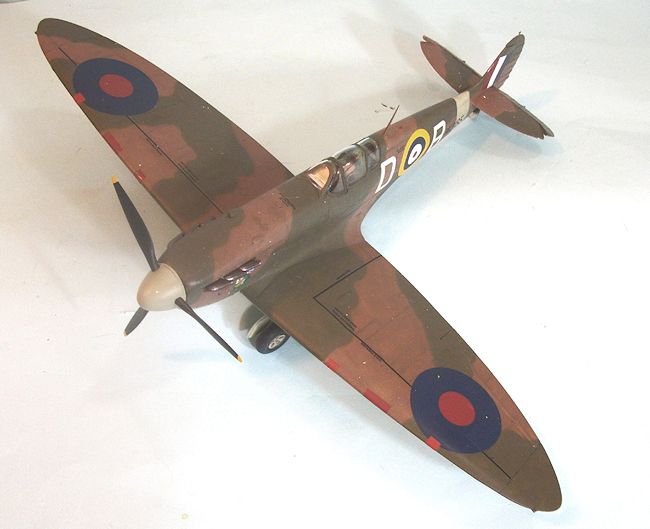 to more
than propaganda and would have changed the way the war was fought, to the profit
of the Allies. As it was, the only
thing the Circus accomplished for the Allies between 1941-43 was to have
something going on nearby which the press could cover and convince the public
Things Were Being Done, and increase the Allied casualty lists for no real
purpose.
to more
than propaganda and would have changed the way the war was fought, to the profit
of the Allies. As it was, the only
thing the Circus accomplished for the Allies between 1941-43 was to have
something going on nearby which the press could cover and convince the public
Things Were Being Done, and increase the Allied casualty lists for no real
purpose.
Douglas Bader himself is a controversial figure in many ways.
His story is compelling, and many of the advances made in the treatment
of amputees and the development of new technology to replace lost arms and legs
is the direct result of his tireless campaigning in the years after the Second
World War until his death in 1982.
The man was an inspiration to all who ever met him and to most of those who
served under him. That said,
Britain is fortunate that his tactical advice wasn’t taken during the Battle of
Britain, and that his advice not to arm the Spitfire with 20mm cannons also went
unheeded. Many of those who served
under him in 1940 and 1941 and caught his fire went on to notable careers in the
rest of the war, most famously his wingman, John Edgar “Johnnie” Johnson, who
went on to become the top-scoring Spitfire pilot of history and the leading RAF
ace in northern Europe with 34 victories, all in Spitfires and all against
single-engine opponents other than two Bf-110s.
Bader exchanged his Spitfire IIa in which he had scored the majority of
his 20 victories for Spitfire Va W3185 in mid-July 1941.
Bader’s continued desire to fly more operations (the wing had been doing
two a day every good weather day since late March) had his pilots in a
near-mutinous state according to 616's CO, Squadron Leader Burton.
He scored at least two and perhaps three victories in the new airplane
before his final mission over northern France on August 9, 1941, which marked
his 62nd mission since March 24.
Bader and his flight spotted 12 Bf-109s below them as they crossed into
France. He dove on the enemy so
fast that he could not get a clear shot and nearly collided with the leader he
was chasing. Becoming separated
from the rest of his flight, he spotted three pairs of 109s below and attacked
them, claiming one. Going after a
second, he saw two others coming in on him and made the mistake of banking away
from them. He always believed he
then collided with one of the two he had been aiming at.
The entire rear fuselage and tail of W3185 was blown off right aft of the
cockpit. Bader attempted to bail
out, but found his prosthetic leg caught on something inside the cockpit.
He finally deployed his parachute and the force of the deployment broke
his leg straps and he was able to successfully escape the airplane.
Researchers have found no Bf-109 lost in a collision that day.
Feldwebel Max Meyer of II./JG 26 claimed he shot down Bader.
According to Luftwaffe records, Leutnant Kosse of 5./JG 26 and
Meyer, of 6./JG 26, were the only pilots to make claims that day. Meyer
mentioned that he followed the downed Spitfire and watched the pilot bail out,
which appears to match this statement in Bader's memoirs: "I was floating in the
sunshine above broken, white cloud ... I heard an aeroplane just after I passed
through. A Bf 109 flew past." Adolf Galland went through every claim record of
JG 26 for that day, even of pilots who failed to return, and could find no
report that matched the circumstances Bader described; he stated that Meyer’s
claim only matched the loss of F/Sgt Haydon of 452 Squadron.
Historian Andy Saunders’ research, published in 2003 in “Who Shot Down
Douglas Bader?”, suggests Bader was shot down by F/Lt Buck Casson of 616
Squadron, who claimed a Bf-109 shot down that lost its tail just before the
pilot bailed out, just before he himself was shot down.
Casson also noted that the pilot appeared to struggle for awhile to get
out.
Bader then went on to his more famous wartime role as the most truculent
RAF POW in Germany.
Revell announced
a new-technology Spitfire IIa earlier this year.
Given their success with low-priced good-quality kits of World War II
subjects in earlier years, modelers were enthusiastic at the news, particularly
statements that the kit was developed from direct measurement of P7849, a
restored Spitfire IIa. The
enthusiasm waned when test shots revealed they’d managed to get the instrument
panel reversed (which has been corrected).
The kit is now out. The
first criticisms were that it had metal ailerons when the IIa mostly had
fabric-covered ailerons, that it lacked the Rotol prop used by the vast majority
of Spitfire IIa aircraft, and that the radiator and oil cooler were more
appropriate for a Spitfire V than a Spitfire IIa, while the gear legs are
strange and the main wheels too small.
The cockpit has several errors, most prominently the seat which is not
the right size and additionally does not use World War II-appropriate “padding.”
Additionally, various of the scoops and bulges on the cowling are
incorrect. This may all have been the result of P7849 being restored with these
items from Spitfire V stocks, which would be more likely available, and that
Revell cut corners in the name of cost containment (which definitely happened
with their two Bf-109G
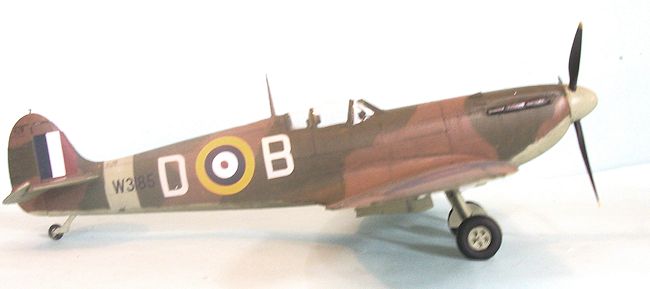 kits).
Most of the negative comments quieted when the “usual suspects” of the
aftermarket quickly announced resin replacement and correction sets.
However, the “cheap” kit was rapidly rising in final price for those who
desire an accurate model.
kits).
Most of the negative comments quieted when the “usual suspects” of the
aftermarket quickly announced resin replacement and correction sets.
However, the “cheap” kit was rapidly rising in final price for those who
desire an accurate model.
Recently, Derek Bradshaw, who is well known as one of the most careful
and conscientious kit reviewers, compared the kit with the well-known Cox
Drawings, which are considered the most accurate for the early Spitfire
sub-types. Those interested can
read his research in detail at Large Scale Planes.
The “quick and dirty” is that the fuselage is a bit long, with the
cockpit location misplaced, and the fuselage too wide in some areas and too
narrow in others. Additionally, the
wing is too thick in section at the root. What’s surprising here is that,
regardless of technical items used in the restoration, one would expect that
simply measuring P7489 correctly should avoid all these problems.
I have to say up
front that I have finally just Had It with Revell instructions.
They are the worst instructions from any company and make construction of
every kit they produce more difficult.
Couple these instructions with kit production design in which parts that
will end up next to each other when assembled are strewn hither and yon on
different sprues (which are not identified in the instructions), and building a
Revell kit can easily resemble an Easter Egg hunt.
It has contributed to the fact that my 1/350 Bismark has sat sans final
detail assembly for several years.
That said, overall the kit fits well, and I only needed to use a very
little bit of filler, mostly along the fuselage centerline on the upper cowling.
As a matter or personal taste, most of the surface detail is way too
heavy even in 1/32, and rivals the worst of Trumpeter.
I don’t know why
they released this kit with the flaps dropped.
Spitfires never sit on the ground with the flaps down unless they’re
being worked on, and all it does to do this is add an unnecessary construction
step to the project. I also noted
while assembling the wing that the bulges over the main
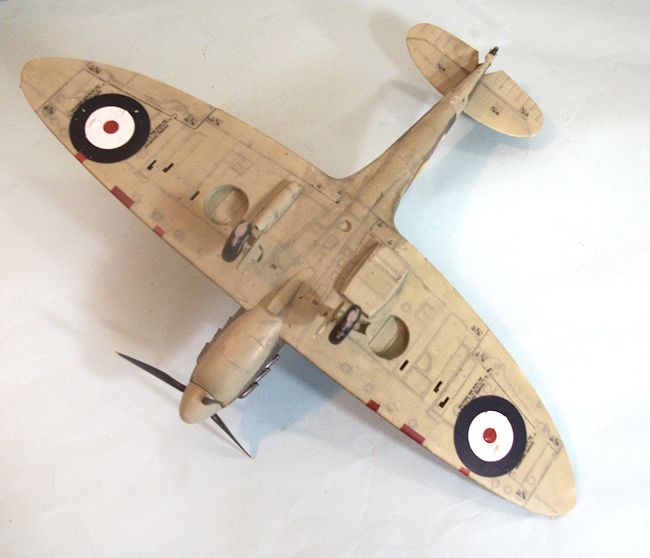 gear
well are completely the wrong shape - which is strange since Revell got the wing
perfectly right when they did the mish-mash update of the old Hasegawa Spitfire
V kit 20 years ago.
gear
well are completely the wrong shape - which is strange since Revell got the wing
perfectly right when they did the mish-mash update of the old Hasegawa Spitfire
V kit 20 years ago.
As I proceeded, I realized
that out of the box the kit is far more a Spitfire Va than a Spitfire IIa, and
so I decided I would use the Lifelike Decals 32-013 sheet that has Bader’s
Spitfire Va and just proceed with an OOB build. Even with that decision, I ended
up replacing the godawful deHavilland prop with the spinner and prop from the
Hasegawa Spitfire V, I also cut up a Hasegawa seat to narrow it properly and
then “upholstered” it with Evergreen rod, and decided to use a set of resin
wheels left over from a Hurricane, which were better than what the kit provided.
The cockpit is very simplified.
I thought about scratchbuilding things to increase the detail, but was
already losing enough enthusiasm about the project, so I just closed it up after
putting in a “more correct” seat, something I haven’t done with a Spitfire model
in a very long time.
Once the kit was assembled, as I looked at it, things seemed “off” about
it overall, the way the Dragon P-51D is “off” from the accurate shape of a
Mustang. It was at this point that
Derek Bradshaw referred me to his analysis and I read the specific details of
what created the “off” look I was seeing.
This “off” look isn’t as bad as the Trumpeter P-51 with the too-narrow
nose and lack of proper airfoil in the wing; as I said, it is more the “off”
look of the Dragon P-51. At a
distance, it is not so noticeable, and a modeler who is not very familiar with
the Spitfire won’t be put off. It
will “look like a Spitfire to me” for most people, but those who know what
they’re looking at and for whom shape is important, are going to be put off by
this kit. Sadly, what makes the kit look “off” are not items that are (or can
be) addressed by aftermarket correction sets.
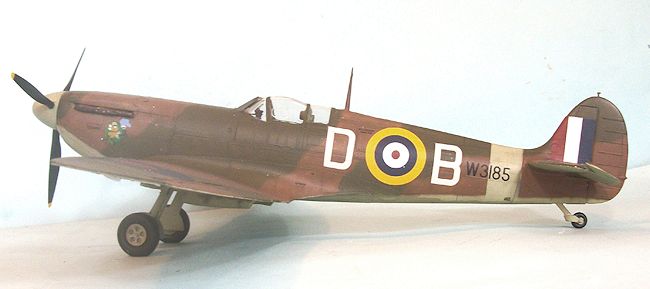 I used Xtracrylix Dark Earth, Dark Green and Sky to do an “A” camouflage
scheme.
I used Xtracrylix Dark Earth, Dark Green and Sky to do an “A” camouflage
scheme.
I alternated using the stencils and national insignia from the Eagle Cals
32-158 sheet with the personal markings for W3185 from the Lifelike sheet.
Everything went down with problems.
Since Bader only had this airplane for a few weeks, I didn’t do more than
apply oil residue on the lower fuselage and exhaust stains for weathering.
I unmasked the canopy after applying a coat of Xtracylix Clear Flat.
Close, but no
cigar. Given that Revell claims
their designers spent up close and personal time with Spitfire P7849, the
geometry and outline mistakes are really inexcusable.
It’s not like there aren’t good plans also available, not to mention
knowledgeable researchers who would be happy to provide the results of their
knowledge. Doing this kit right
should have been a no-brainer.
I have been
informed by a knowledgeable source that, rather than take all their information
from P7489, Revell actually did all their detail research on the
heavily-modified AR213, which has had many parts replaced over the years with
what was available at the time.
This likely explains why the kit is more a Spitfire V than a Spitfire II in its
detail. The fact that Revell didn’t
ask any of the several excellent Subject Matter Experts in Britain to check over
their work before committing to
plastic demonstrates clearly why this is “a swing and a miss.”
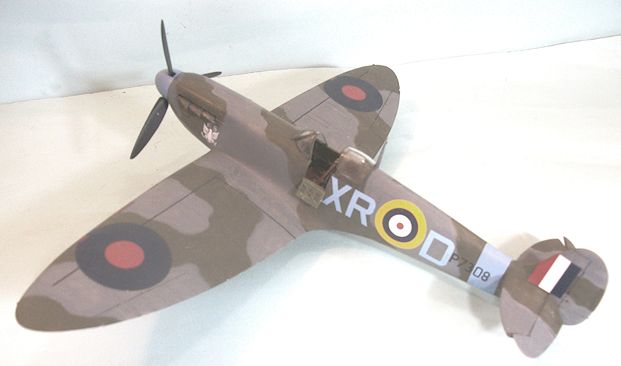 As a demonstration of what they
could have done, I am providing a picture of my Hasegawa-Revell Spitfire
II “mismash” that has been released over the last 20 years or so with the 1970s
vintage Hasegawa Spitfire V kit mated to a new set of 8-gun wings, using the
kit-provided Rotol prop with Rotol “Jablo” blades from the Greymatter Hurricane
II conversion. Hannant’s has
released a very nice decal sheet - 32054 - of Spitfire IIs, one of which is for
Bill Dunn’s airplane from 71 Eagle Squadron.
I stripped this model and repainted it to use these markings.
As a demonstration of what they
could have done, I am providing a picture of my Hasegawa-Revell Spitfire
II “mismash” that has been released over the last 20 years or so with the 1970s
vintage Hasegawa Spitfire V kit mated to a new set of 8-gun wings, using the
kit-provided Rotol prop with Rotol “Jablo” blades from the Greymatter Hurricane
II conversion. Hannant’s has
released a very nice decal sheet - 32054 - of Spitfire IIs, one of which is for
Bill Dunn’s airplane from 71 Eagle Squadron.
I stripped this model and repainted it to use these markings.
Revell would have
done themselves a big favor to have updated this old kit, since it has fewer
mistakes in it than their new kit has.
I’m thinking
seriously of getting the 45 year old original Revell 1/32 Spitfire I and mating
it to the Greymatter correction set.
I think I’ll be more successful getting an early Spitfire that’s closer
to right that way.
This kit reminds
me of the Eduard Bf-109G-6, which is also “a swing and a miss,” though it looks
nice when completed. For the
modeler looking for “value for money” who isn’t a Spitfire afficionado, the kit
is OK. In conclusion, there is
still room for someone to do an early Spitfire in 1/32 scale.
Tom
Cleaver
September 2014
Review kit courtesy of my wallet.
If you would like your product reviewed fairly and quickly, please
contact the editor
or see other details in the
Note to
Contributors.
Back to the Main Page
Back to the Review
Index Page


 The Spitfire V first appeared as the Type 331, known as the Spitfire Va.
94 were built with the “A” wing carrying eight .303 Colt-Browning machine
guns. This sub-type had a top speed
of 375 mph, and could climb to 20,000 feet in 7.1 seconds.
The best known of these Spitfires is W3185, which was flown by Douglas
Bader as commander of the Tangmere Wing and in which he was lost on August 9,
1941.
The Spitfire V first appeared as the Type 331, known as the Spitfire Va.
94 were built with the “A” wing carrying eight .303 Colt-Browning machine
guns. This sub-type had a top speed
of 375 mph, and could climb to 20,000 feet in 7.1 seconds.
The best known of these Spitfires is W3185, which was flown by Douglas
Bader as commander of the Tangmere Wing and in which he was lost on August 9,
1941. to more
than propaganda and would have changed the way the war was fought, to the profit
of the Allies. As it was, the only
thing the Circus accomplished for the Allies between 1941-43 was to have
something going on nearby which the press could cover and convince the public
Things Were Being Done, and increase the Allied casualty lists for no real
purpose.
to more
than propaganda and would have changed the way the war was fought, to the profit
of the Allies. As it was, the only
thing the Circus accomplished for the Allies between 1941-43 was to have
something going on nearby which the press could cover and convince the public
Things Were Being Done, and increase the Allied casualty lists for no real
purpose. kits).
Most of the negative comments quieted when the “usual suspects” of the
aftermarket quickly announced resin replacement and correction sets.
However, the “cheap” kit was rapidly rising in final price for those who
desire an accurate model.
kits).
Most of the negative comments quieted when the “usual suspects” of the
aftermarket quickly announced resin replacement and correction sets.
However, the “cheap” kit was rapidly rising in final price for those who
desire an accurate model. gear
well are completely the wrong shape - which is strange since Revell got the wing
perfectly right when they did the mish-mash update of the old Hasegawa Spitfire
V kit 20 years ago.
gear
well are completely the wrong shape - which is strange since Revell got the wing
perfectly right when they did the mish-mash update of the old Hasegawa Spitfire
V kit 20 years ago.
 As a demonstration of what they
could have done, I am providing a picture of my Hasegawa-Revell Spitfire
II “mismash” that has been released over the last 20 years or so with the 1970s
vintage Hasegawa Spitfire V kit mated to a new set of 8-gun wings, using the
kit-provided Rotol prop with Rotol “Jablo” blades from the Greymatter Hurricane
II conversion. Hannant’s has
released a very nice decal sheet - 32054 - of Spitfire IIs, one of which is for
Bill Dunn’s airplane from 71 Eagle Squadron.
I stripped this model and repainted it to use these markings.
As a demonstration of what they
could have done, I am providing a picture of my Hasegawa-Revell Spitfire
II “mismash” that has been released over the last 20 years or so with the 1970s
vintage Hasegawa Spitfire V kit mated to a new set of 8-gun wings, using the
kit-provided Rotol prop with Rotol “Jablo” blades from the Greymatter Hurricane
II conversion. Hannant’s has
released a very nice decal sheet - 32054 - of Spitfire IIs, one of which is for
Bill Dunn’s airplane from 71 Eagle Squadron.
I stripped this model and repainted it to use these markings.